Gaslighting manipulates reality to make someone doubt their perceptions, while lying simply involves delivering false information. Discover the key differences and how to recognize each behavior in this article.
Table of Comparison
| Aspect | Gaslighting | Lying |
|---|---|---|
| Definition | Manipulative tactic causing doubt in a person's memory or perception. | Deliberate false statement to deceive or mislead. |
| Intent | To control, confuse, and undermine confidence. | To hide truth or gain advantage. |
| Impact on Victim | Emotional distress, self-doubt, loss of trust. | Misled, deceived, trust issues. |
| Duration | Often prolonged and repeated over time. | Can be one-time or occasional. |
| Example | "You're imagining things; that never happened." | "I was at work all day." (When false) |
| Communication Style | Inductive, emotionally manipulative. | Direct falsehood. |
Understanding Gaslighting: Definition and Origins
Gaslighting is a psychological manipulation tactic where false information is presented to make victims doubt their memory and perception, often leading to confusion and loss of confidence. Unlike outright lying, which simply involves telling falsehoods, gaslighting is a sustained, insidious effort to destabilize a person's sense of reality. The term originates from the 1938 play "Gas Light" and its subsequent film adaptations, where a husband manipulates his wife into questioning her sanity by dimming gas lights and denying the change.
What Constitutes Lying: Key Characteristics
Lying involves deliberately providing false information with the intent to deceive or mislead someone, often characterized by a clear contradiction to factual reality. It focuses on explicit verbal or written falsehoods without necessarily manipulating the perception of reality over time. Unlike gaslighting, which is a sustained effort to distort a person's sense of truth and memory, lying is typically a one-time act aimed at concealing the truth or gaining an advantage.
Gaslighting vs. Lying: Core Differences
Gaslighting manipulates your perception of reality by making you doubt your memories and feelings, while lying simply involves stating false information. Gaslighting is a psychological abuse tactic designed to control and destabilize, whereas lying may be used for various purposes without necessarily aiming to undermine your mental state. Understanding these core differences helps you recognize emotional abuse versus straightforward dishonesty in relationships.
Psychological Impact of Gaslighting
Gaslighting uniquely erodes Your sense of reality by causing deep psychological distress, confusion, and self-doubt, unlike simple lying which only involves falsehood without manipulation of perception. The psychological impact of gaslighting includes long-term trauma, anxiety, depression, and a diminished ability to trust others or oneself. This emotional manipulation compromises mental health, making it more damaging than mere deception.
Effects of Lying in Relationships
Lying in relationships erodes trust, creating emotional distance and insecurity that undermines the foundation of intimacy. When your partner deceives you, it triggers confusion and self-doubt, often leading to anxiety and damaged communication patterns. Recognizing the difference between lying and gaslighting is crucial, as gaslighting manipulates your reality, intensifying emotional harm beyond the betrayal caused by lying alone.
Signs You’re Experiencing Gaslighting
Signs you're experiencing gaslighting include persistent denial of your reality, where someone consistently contradicts your memories or feelings to make you doubt yourself. You may notice increased confusion, anxiety, or second-guessing your perception of events despite clear evidence to the contrary. Recognizing these behaviors is crucial to protect your mental health and establish boundaries against manipulative tactics like gaslighting, which differs from simple lying by its goal to destabilize your sense of reality.
Common Scenarios: Gaslighting and Lying in Daily Life
Gaslighting often occurs in relationships where one partner manipulates the other's perception of reality, such as denying events or feelings to sow doubt and confusion. Lying is prevalent in daily interactions, including workplace settings, where individuals may provide false information to avoid responsibility or gain advantage. Both behaviors overlap in scenarios like denial of wrongdoing, but gaslighting uniquely distorts memory and truth to undermine the victim's trust in their own judgment.
Why People Gaslight vs. Why People Lie
People gaslight to manipulate and control others by making them doubt their perceptions and reality, often to maintain power or avoid accountability. Lying involves deliberately providing false information to deceive, protect oneself, or gain an advantage without necessarily distorting the victim's sense of reality. Understanding why you might encounter gaslighting versus lying helps in recognizing these behaviors and protecting your mental well-being.
How to Respond to Gaslighting and Lies
Recognizing gaslighting involves identifying manipulative tactics aimed at distorting your reality, while lying simply entails presenting false information without altering your perception. To respond effectively, assert your truth calmly and document incidents when possible, reinforcing your confidence in your own experiences. Trusting your instincts and seeking support from trusted individuals empowers you to confront deception and reclaim control over your reality.
Healing and Recovery from Gaslighting and Deception
Healing from gaslighting requires recognizing the deep emotional manipulation that goes beyond simple lying, as gaslighting distorts your perception of reality and undermines your self-trust. Recovery involves rebuilding your sense of self through therapy and supportive relationships that validate your experiences and reinforce your truth. Addressing both the deceit and the psychological impact is crucial for regaining confidence and fostering long-term emotional resilience.

Infographic: Gaslighting vs Lying
 relatioo.com
relatioo.com